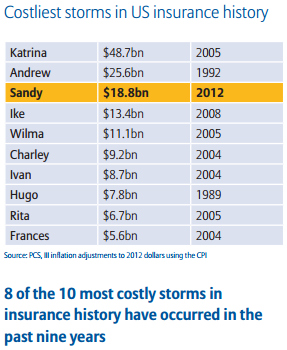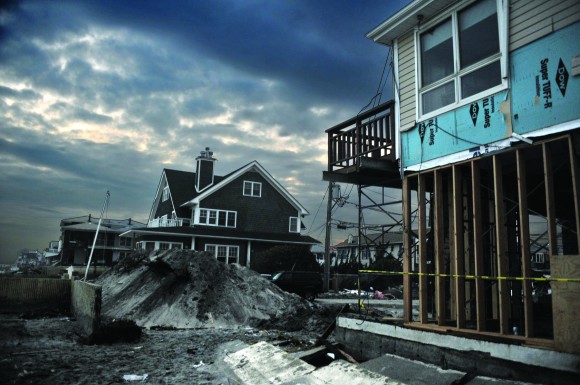Superstorm Sandy made landfall as a post-tropical cyclone on the U.S. East Coast October 29, 2012 after cutting a destructive path through the Bahamas, Cuba, the Dominican Republic, Haiti, Jamaica and Puerto Rico.
Sandy is the deadliest windstorm to have occurred in the Northeastern United States in 40 years, resulting in more than 280 fatalities. The following figures further illustrate the cost of the disaster.
• Total economic losses from Superstorm Sandy have now reached $70 billion, according to market estimates.
• Sandy damaged or destroyed about 650,000 homes and knocked out power to 8.5 million customers

• Insured losses total approximately $25.85 billion. Private insurance companies account for approximately three quarters (73 percent) of this total.
• Auto, homeowners and business insurance claim payouts total $18.75 billion.
• The rest is covered by the National Flood Insurance Program ($7.1 billion).
• Sandy is the third costliest insured U.S. natural catastrophe after Hurricanes Katrina ($48.7 billion) and Andrew ($25.6billion), based on private insurance company losses only.
• Some 1.58 million Sandy claims have been filed with private insurance companies, most of which were homeowners’ insurance claims (71.5 percent).
• Businesses accounted for almost half (47.6 percent) of the privately-insured loss from Sandy.
• The average commercial claim was more than $44,500, compared with about $6,500 for homeowners.
• It is estimated that the storm will cost $30 billion when flood, marine and aviation insurance claims are all included.
From Allianz Global Corporate & Specialty’s October report “Superstorm Sandy Lessons learned: A risk management perspective,” with figures from New York Climate Week 2013, Insurance Information Institute, Insurance Services Office’s Property Claim Services (PCS) unit, National Flood Insurance Program, Munich Re.
Topics USA
Was this article valuable?
Here are more articles you may enjoy.



 Wildfires, Storms Fuel 2025 Insured Losses of $108 Billion: Munich Re Report
Wildfires, Storms Fuel 2025 Insured Losses of $108 Billion: Munich Re Report  10 Highest Class-Action Settlements in 2025 Eclipsed $70B Total: Duane Morris
10 Highest Class-Action Settlements in 2025 Eclipsed $70B Total: Duane Morris  Experian: AI Agents Could Overtake Human Error as Major Cause of Data Breaches
Experian: AI Agents Could Overtake Human Error as Major Cause of Data Breaches  Expense Ratio Analysis: AI, Remote Work Drive Better P/C Insurer Results
Expense Ratio Analysis: AI, Remote Work Drive Better P/C Insurer Results 

